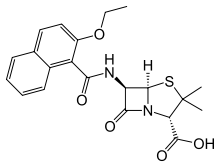Nafcillin
Nafcillin sodium is a narrow-spectrum[1] beta-lactam antibiotic[2] of the penicillin class. As a beta-lactamase-resistant penicillin, it is used to treat infections caused by Gram-positive bacteria, in particular, species of staphylococci that are resistant to other penicillins.
 | |
| Clinical data | |
|---|---|
| AHFS/Drugs.com | Monograph |
| MedlinePlus | a685019 |
| Pregnancy category |
|
| Routes of administration | IM, IV |
| ATC code | |
| Legal status | |
| Legal status |
|
| Pharmacokinetic data | |
| Protein binding | 90% |
| Metabolism | <30% hepatic |
| Elimination half-life | 0.5 hours |
| Excretion | Biliary and renal |
| Identifiers | |
| |
| CAS Number | |
| PubChem CID | |
| DrugBank | |
| ChemSpider | |
| UNII | |
| ChEBI | |
| ChEMBL | |
| CompTox Dashboard (EPA) | |
| ECHA InfoCard | 100.005.174 |
| Chemical and physical data | |
| Formula | C21H22N2O5S |
| Molar mass | 414.48 g·mol−1 |
| 3D model (JSmol) | |
| |
| |
| (verify) | |
Nafcillin is considered therapeutically equivalent to oxacillin, although one retrospective study found greater rates of hypokalemia and acute kidney injury in patients taking nafcillin compared to patients taking oxacillin.[3]
Indications
Nafcillin is indicated in the treatment of staphylococcal infections, except those caused by MRSA.[4]
U.S. clinical practice guidelines recommend either nafcillin or oxacillin as the first-line treatment of choice for staphylococcal endocarditis in patients without artificial heart valves.[5]
Side-effects
As with all penicillins, serious life-threatening allergic reactions can occur.
Milder side-effects include:
- Hypokalemia[6]
- Nausea and vomiting
- Diarrhea, often due to suppression of normal gastrointestinal bacteria, which, on occasion, leads to a more serious super-infection with an organism like Clostridium difficile
- Abdominal pain
- Yeast infections (thrush) affecting the mouth and tongue or vagina
- Agranulocytosis, neutropenia
Interactions
There is evidence that nafcillin induces cytochrome P-450 enzymes, specifically CYP2C9. Several drugs with a narrow therapeutic window, such as warfarin and nifedipine, are metabolized by CYP2C9.[7]
Nafcillin contains salts added as stability media. These added salts could cause edema or fluid accumulation. It would be prudent to avoid this medication if there were a concern for a congestive heart failure or kidney disease.
References
- Palmer DL, Pett SB, Akl BF (March 1995). "Bacterial wound colonization after broad-spectrum versus narrow-spectrum antibiotics". Ann. Thorac. Surg. 59 (3): 626–31. doi:10.1016/0003-4975(94)00992-9. PMID 7887701.
- Tan AK, Fink AL (January 1992). "Identification of the site of covalent attachment of nafcillin, a reversible suicide inhibitor of beta-lactamase". Biochem. J. 281 (1): 191–6. doi:10.1042/bj2810191. PMC 1130660. PMID 1731755.
- Viehman, J. Alexander; Oleksiuk, Louise-Marie; Sheridan, Kathleen R.; Byers, Karin E.; He, Peimei; Falcione, Bonnie A.; Shields, Ryan K. (May 2016). "Adverse Events Lead to Drug Discontinuation More Commonly among Patients Who Receive Nafcillin than among Those Who Receive Oxacillin". Antimicrobial Agents and Chemotherapy. 60 (5): 3090–3095. doi:10.1128/AAC.03122-15. PMC 4862451. PMID 26976858.
- Pham P, Bartlett JG (January 2, 2009). "Nafcillin". Point-of-Care Information Technology ABX Guide. Johns Hopkins University. Retrieved on July 10, 2009. Freely available with registration.
- Bonow RO, Carabello BA, Kanu C, et al. (August 2006). "ACC/AHA 2006 guidelines for the management of patients with valvular heart disease: a report of the American College of Cardiology/American Heart Association Task Force on Practice Guidelines (writing committee to revise the 1998 Guidelines for the Management of Patients With Valvular Heart Disease): developed in collaboration with the Society of Cardiovascular Anesthesiologists: endorsed by the Society for Cardiovascular Angiography and Interventions and the Society of Thoracic Surgeons". Circulation. 114 (5): e84–231. doi:10.1161/CIRCULATIONAHA.106.176857. PMID 16880336.
- JA Mohr. (1979). Nafcillin-associated hypokalemia. JAMA
- Lang CC, Jamal SK, Mohamed Z, Mustafa MR, Mustafa AM, Lee TC (June 2003). "Evidence of an interaction between nifedipine and nafcillin in humans". Br J Clin Pharmacol. 55 (6): 588–90. doi:10.1046/j.1365-2125.2003.01789.x. PMC 1884262. PMID 12814453.